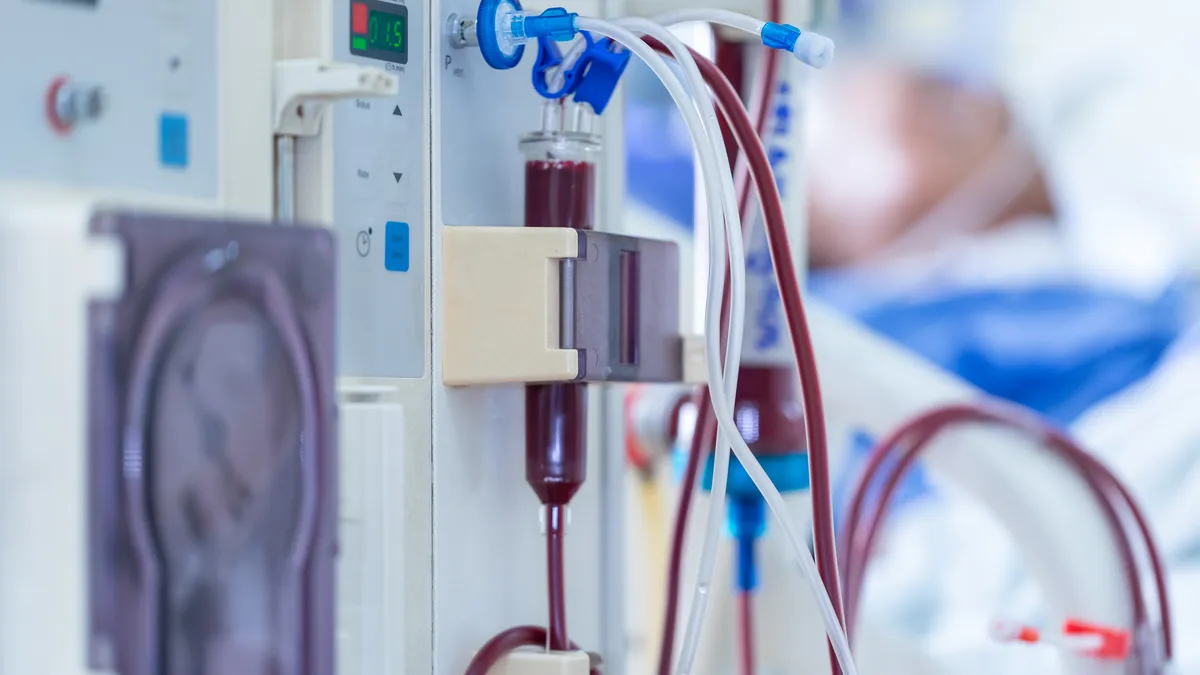Advanced peripheral artery disease (PAD) below the knee has proven challenging to treat. Balloon angioplasty, the current standard of care, has been linked to poor outcomes, and the medical device industry has struggled to develop safe, effective treatments.
However, Abbott recently received FDA approval for its Esprit device, a dissolvable, everolimus-coated stent designed to prop open blood vessels below the knee in patients with chronic limb-threatening ischemia. Abbott now has the only stent on the U.S. market to treat the condition.
The device, which has scaffolding that dissolves after three years to reduce the risk of late complications, has been connected to improved outcomes for below-the-knee procedures compared with angioplasty.
MedTech Dive spoke with Jennifer Jones-McMeans, Abbott’s divisional vice president of global clinical affairs for the vascular business, about what the new approach to treating below-the-knee PAD means for patients.
This interview has been edited for length and clarity.
MEDTECH DIVE: Why is the approval of the Esprit stent important for patients with peripheral artery disease?
JENNIFER JONES-MCMEANS: This really is a landmark moment for people with the severe form of peripheral artery disease. This is the first of its kind in the United States, an FDA approved, dissolving stent to treat arteries from below the knee. PAD, the severe form, is really an end-stage disease, when you look at the PAD timeline. What's even more upsetting is that PAD is the most prevalent disease that no one has heard about. This makes it very challenging.
We have about 20 million people in the United States who are living with peripheral artery disease in the most severe form, and the diagnosis is only about 10%. If you think about how important this is to improve awareness and education, part of this goes to the fact that the mortality rate in the first year for the most severe form of PAD exceeds that of an overall five-year mortality rate of breast cancer, colorectal cancer, prostate cancer. It is a very devastating disease.
What are the limitations of the current standard of care for these patients?
The current standard of practice, for a non-surgical or minimally invasive procedure, is called balloon angioplasty. It is a balloon that goes into those arteries below the knee and pushes the plaque back, and that's all it does. And when you do that, you can really injure the arterial lining that is already diseased, and then it's going to be closed. Sometimes, these patients are coming back to open the artery again.
That recurrent closure leads to wounds on the feet and on parts of the leg that don't heal. Over time, if left untreated, there is a higher risk of amputation. When you have that higher risk of amputation, you have now created another risk, death. The amputation risk of these patients is anywhere from about 20% to 25% at one year, and greater than 50% of these people with a major amputation potentially could be dead in five years.
What has your research shown about the safety and effectiveness of the Esprit stent?
We learned in collaborating with the FDA that the endpoints by which you evaluate these technologies matter. What we were able to identify is how to best measure that this device works. Esprit works better than balloon angioplasty.
From six months to one year, there was a huge drop off with balloon angioplasty and its ability to keep the vessel open and the disease from progressing, where Esprit was able to show far more successfully – it was about a 30% difference – that from about six months to one year after the patient was treated, the vessel remained open and you had a slower progression, or reclosure, of that disease.
What is the benefit of the stent dissolving?
It's a polymer that dissolves, similar to dissolving resorbable stitches. Now some may ask, ‘Well, don't I need something to hold the vessel open for a long period of time?’ You don't. The vessel over time, if it's propped up, after a while the vessel gets it, and it won't re-close, especially when I have a drug on the dissolving stent which will reduce the inflammatory response in that re-growth tissue.
Why is PAD on the rise?
In general, we see cardiovascular disease continues to increase. One thing that's very important to note about this severe form of PAD is that 50% to 70% of diabetics potentially will be diagnosed with this. So diabetes is an uncomfortable partner. It is a very large population that we are looking at.
How did Abbott make sure the LIFE-BTK study was inclusive of people of color?
It was very intentional, as we knew we were interested in this. With peripheral artery disease and the most severe form, unfortunately, it is disproportionately impacting people who are people of color – African Americans, the Hispanic population, the Native American population. We found that it was essential, if we were going to evaluate a technology for approval in this disease state, that we ensure that these patients were included in our trial.
We have to ensure that we are providing the patients with the appropriate resources in order for them, number one, to feel comfortable with understanding the disease. Number two, to feel comfortable with understanding their treatment options. Then, if they decide to be in the trial, how are we going to resource it to reduce the barriers to participate?
We have a LIFE-BTK website, where patients' families can go on and be educated about this disease. We have videos, all sorts of materials that they saw themselves in. That allowed for conversations to happen outside of the doctor's office, as well as with the physician.
We know that access is a key issue, and we didn't want to make it too challenging. These patients are already challenged with their health. How can we make it easier? Well, we can come to them. We set up a system in which we were able to come to them, with assessments done at their home. If they did have to come in, we had certain reimbursement for transportation. If there was a need for lodging, we had those reimbursement pieces set in.
We also felt it was important that we had a diverse set of healthcare workers that were actually supporting the patient. We identified certain investigators and supported them and their clinical sites in order to participate in the trial, because patients want to be seen by those who look and sound like them, giving them comfort in the process.


















